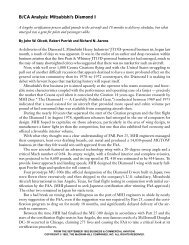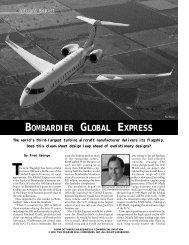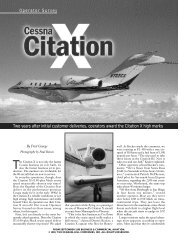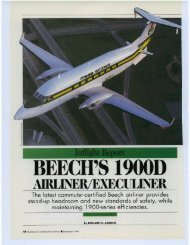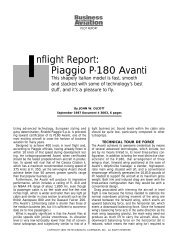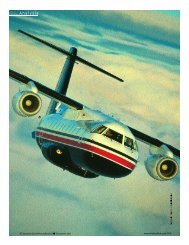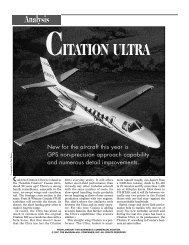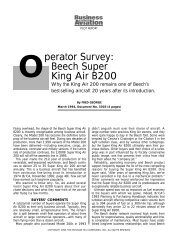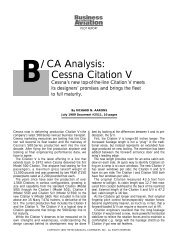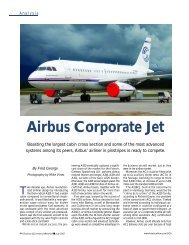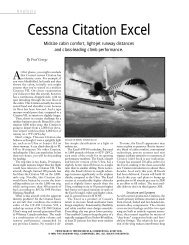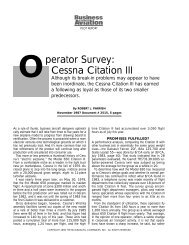Operations: Cessna 441 Conquest II
Operations: Cessna 441 Conquest II
Operations: Cessna 441 Conquest II
You also want an ePaper? Increase the reach of your titles
YUMPU automatically turns print PDFs into web optimized ePapers that Google loves.
<strong>Operations</strong><br />
<strong>Cessna</strong> <strong>441</strong><br />
<strong>Conquest</strong> <strong>II</strong><br />
Operation<br />
By Edward G. Tripp<br />
Photography by Paul Bowen<br />
Designed for performance and dubbed<br />
“Jetprop,” the <strong>Conquest</strong> <strong>II</strong> overcame early<br />
troubles to star again in the nineties.<br />
<strong>Cessna</strong> entered the turboprop market<br />
in 1977 with the CE-<strong>441</strong>, well<br />
after Beech and Rockwell Commander<br />
had established themselves in<br />
that market segment. Originally tradenamed<br />
“<strong>Conquest</strong>,” <strong>Cessna</strong>’s AlliedSignal<br />
TPE331-8 powered airplane was<br />
renamed “<strong>Conquest</strong> <strong>II</strong>” in 1983. The <strong>441</strong><br />
was designed for performance and actually<br />
outperformed some early Citations in<br />
selected parameters. Indeed, some companies<br />
offering aftermarket performance<br />
mods for today’s <strong>Conquest</strong> fleet say an<br />
updated CE-<strong>441</strong> can still run head-tohead<br />
with the Citation <strong>II</strong>.<br />
The <strong>441</strong>’s cabin is large. It can accommodate<br />
11 passenger seats in commuter<br />
configuration, and, more typically, six or<br />
seven seats in executive configuration.<br />
The airplane’s long nose has two separate<br />
baggage bays, with the avionics rack in<br />
the forward bay and the batteries stowed<br />
under the rear bay floor. There also is a<br />
large baggage area in the aft cabin. The<br />
cabin has a large two-part airstair door,<br />
and a wide, three-part door option was<br />
available.<br />
The cockpit is laid out in typical <strong>Cessna</strong><br />
400 series fashion, reflecting the lessons<br />
learned in developing the muchpraised<br />
Citation cockpit. Pilot seats are<br />
comfortable and large and there is good<br />
visibility out of the cockpit windows.<br />
Standard avionics, which included an<br />
RMI, transponder with encoder, weather<br />
radar and a flight control system, was<br />
(except for the radar) from <strong>Cessna</strong>’s electronics<br />
subsidiary, Aircraft Radio Corp.<br />
(ARC). An optional Collins package,<br />
which many customers preferred, was<br />
available. However, the FCS 1000 flight<br />
director was the only FCS available until<br />
the very end of production. Ultimately<br />
some 15 airplanes went out the door with<br />
the Sperry (Honeywell) SPZ-500.<br />
Many turboprops of the day were poor<br />
performers between 17,000 and 25,000<br />
feet because of powerplant and environmental<br />
system limitations. But, the <strong>Conquest</strong><br />
<strong>II</strong> can roll right up to and above FL<br />
300 except in very high temperatures.<br />
Early <strong>441</strong>’s can reach FL 330 in about 25<br />
minutes using a recommended cruise<br />
climb of 160 KIAS (130 above FL 250) in<br />
ISA standard day conditions after a takeoff<br />
at a MTOW of 9,850 pounds.<br />
Cruise speed tops out at 276 KTAS.<br />
Maximum effort, zero-wind, VFR range<br />
is just under 2,000 nm. (See the accompanying<br />
specifications.)<br />
The performance of the <strong>Conquest</strong><br />
extends beyond all-out speed or seatsempty<br />
range. It offers flexibility, comfortably<br />
handling the more typical (shorter)<br />
distances of most business trips and hauling<br />
a lot of payload, while still providing<br />
near-jet performance to handle longer<br />
legs.<br />
Development<br />
A total of 362 CE-<strong>441</strong>’s were manufactured.<br />
According to Aviation Data Ser-<br />
FROM OCTOBER 1998 BUSINESS & COMMERCIAL AVIATION.<br />
© 1998, THE McGRAW-HILL COMPANIES, INC. ALL RIGHTS RESERVED.
The CE-<strong>441</strong> horizontal stabilizer (below) was designed with<br />
pronounced dihedral to minimize the effects of propeller whirl mode<br />
vibration, but failures required significant redesign. Right: The long<br />
nose provides generous baggage space and easy access.<br />
vice, Inc. of Wichita, 316 remain on the<br />
active registry. Some 203 are registered in<br />
the United States. <strong>Cessna</strong> built 70 <strong>Conquest</strong>s<br />
in the first production year, 39 in<br />
1979, 63 in 1980, 52 in 1981, and 40 in<br />
1982. Production was spotty thereafter<br />
with 48 manufactured in 1983, 20 in<br />
1984, 19 in 1985 and 11 in 1986, the last<br />
production year.<br />
The CE-<strong>441</strong> was grounded twice during<br />
its first two years in service. Failure of<br />
the trim tab actuator jack screws and subsequent<br />
elevator flutter led to in-flight<br />
airframe failure of the sixth production<br />
airplane.<br />
The final fix was a complete redesign of<br />
the horizontal tailplane, including thicker<br />
skins, a redesigned leading edge and elevators,<br />
additional ribs and a second spar<br />
in the horizontal stabilizer. The fix<br />
included a new aft fairing and dual trim<br />
tab actuators. The AD (79-19-13) detailing<br />
the modification also required inspection<br />
and modification or replacement of<br />
the tailcone shelf assembly. The model<br />
was re-certificated in 1979. The first 109<br />
production aircraft are 1978 and 1979<br />
models. The AD applied to Serial Numbers<br />
001 to 0106 and to Serial Number<br />
0109.<br />
<strong>Cessna</strong> worked vigorously to support<br />
its customers during the lengthy tail-fix<br />
down time, including supplying them<br />
with replacement piston twins while the<br />
<strong>441</strong> fix was developed. In a big step forward<br />
in customer service, <strong>Cessna</strong> also<br />
developed fixes for other shortcomings<br />
and frequently picked up much of the<br />
cost, too.<br />
During its short manufacturing span,<br />
list price of a factory-equipped airplane<br />
nearly doubled from $925,000 to<br />
$1,795,000.<br />
For the 1981 model year, maximum<br />
operating altitude was increased to FL<br />
350, beginning with Serial Number 0173.<br />
<strong>Cessna</strong> offered a high-altitude kit (SK<br />
<strong>441</strong>-36) to owners of earlier aircraft. At<br />
the same time, the single battery switch<br />
was changed to individual switches for<br />
each of the two nickel cadmium batteries,<br />
and a service retrofit kit was made available<br />
for this change, as well (SK <strong>441</strong>-37).<br />
Operating experience turned up a number<br />
of other problems that were<br />
addressed during the production run.<br />
The engine fuel nozzles, for example,<br />
proved troublesome in service, and the<br />
combustion chamber was prone to carbon<br />
buildup, which not only reduced performance<br />
but also could create hot spots<br />
that could lead to combustor damage.<br />
Starter/generators and batteries provided<br />
less than optimum service in the field.<br />
The windows developed a number of<br />
problems early on, including delamination,<br />
and improved units were developed.<br />
Many operators converted to glass<br />
windshields.<br />
<strong>Cessna</strong> made many of the product<br />
improvement service bulletins and kits<br />
available at no charge to operators.<br />
Among several changes introduced at<br />
Serial Number 0260 (during the 1982<br />
model year) was the addition of windshield<br />
defog blowers to help handle condensation<br />
in the cockpit (SK <strong>441</strong>-72).<br />
The last major change was the introduction<br />
of an engine power management system<br />
(PMS) with Serial Number 0340.<br />
Service kit SK <strong>441</strong>-79 was made available<br />
for retrofit.<br />
The End of the Line<br />
There is some question about whether<br />
any <strong>441</strong>’s were actually built in 1986 or<br />
whether they were actually inventory<br />
built in 1984 or 1985 and carried forward.<br />
More important is that <strong>Cessna</strong> had<br />
reached the end of the line for all turboprop<br />
products except for the single<br />
P&WC PT6 powered Caravan. In 1986,<br />
<strong>Cessna</strong> evaluated a follow-on, economy<br />
version of the <strong>441</strong>, powered by PT6s. It<br />
was not a go then, nor did it pass muster<br />
with the dealer organization in the early<br />
1990s when planners again proposed the<br />
program. Dealers thought the P&WCpowered<br />
version would be a step backwards<br />
because, in the words of one, “it<br />
couldn’t climb, go as fast or as high as the<br />
<strong>Conquest</strong> <strong>II</strong>.”<br />
Despite fairly extensive service problems<br />
with the AlliedSignal TPE331-8<br />
engines, there have been only five ADs<br />
issued to date. Three—92-02-19, 93-02-<br />
19, which superseded the previous AD,<br />
and 93-02-01—addressed fuel manifold<br />
problems. They all had very short compliance<br />
periods. The most recent, 95-16-<br />
08, required an extensive review of<br />
records and mandatory engine disassembly<br />
if any major work had been done by<br />
Fliteline Maintenance of Wharton, Texas<br />
and two specifically named mechanics, or<br />
if any life-limited parts had been supplied<br />
by them.<br />
The most recent ADs are blanket ones,<br />
affecting many aircraft. AD 97-25-04,<br />
requires changes to the AFM to prohibit<br />
positioning the power levers below the<br />
flight idle stop in flight. Another directive<br />
affects operation in icing conditions (See<br />
Intelligence, April 1998, page 20.)<br />
According to one <strong>Conquest</strong> specialist,<br />
John Berizzi, business development manager<br />
at Executive Wings, Inc. of Lakeland,<br />
Fla., “AD searches on <strong>Conquest</strong>s<br />
are fairly easy. We do a number of prebuy<br />
inspections, and ADs and service bulletins<br />
are not big issues. The main<br />
questions are whether the customer is<br />
getting a good airplane for the price.”<br />
Propulsion System<br />
The TPE331-8, rated at 636 shp, and<br />
developed for the CE-<strong>441</strong>, provided<br />
excellent performance for the price.<br />
FROM OCTOBER 1998 BUSINESS & COMMERCIAL AVIATION.<br />
© 1998, THE McGRAW-HILL COMPANIES, INC. ALL RIGHTS RESERVED.
<strong>Operations</strong><br />
Specifications<br />
<strong>Cessna</strong> <strong>Conquest</strong> <strong>II</strong> CE-<br />
<strong>441</strong><br />
Cockpit design of the <strong>Conquest</strong> <strong>II</strong> wins praise from pilots for good layout, generous space. Visibility is<br />
good. Original equipment ARC avionics, including analog ARC 1000 flight control system, are weak points.<br />
In typical executive configuration, the cabin can seat six in comfort. Noise and vibration levels, largely<br />
generated by propeller wash, and regulation of temperature are regular passenger complaints.<br />
However, reliability issues quickly arose.<br />
Fuel nozzle problems and maintenance<br />
requirements, carbon buildup in the combustor<br />
and performance deterioration in<br />
relatively few operating hours due to turbine<br />
blade erosion were among operator<br />
complaints. (See “Operator Survey,”<br />
November 1984, page 42).The -8 has<br />
short major service intervals—hot section<br />
inspections at 1,500-hour intervals and a<br />
3,000-hour TBO. Operators have not<br />
liked the high cost of major maintenance,<br />
either.<br />
Executive Wings claims to be the pioneer<br />
in upgrading the -8 for maintainability<br />
and reliability, obtaining two STCs in<br />
March 1991. The improvements developed<br />
involve exchanging the -8 combustor<br />
and turbine with components<br />
developed for the TPE331-10 series.<br />
This change addresses another issue,<br />
since the -10 includes duplex, two-headed<br />
fuel nozzles. At first, the company called<br />
its mods the “Super 8 Engine Conversion.”<br />
It is now trademarked as the<br />
“Executive Five Eleven” conversion.<br />
HSI is extended to 2,500 hours; TBO is<br />
stretched to 5,000 hours. Among other<br />
advantages Executive Wings claims are<br />
reduction of HSI costs of from 30 to 50<br />
percent, fuel nozzle maintenance costs<br />
cut by as much as 75 percent—from an<br />
average of $8 per hour to $2—and<br />
reduced turbine blade carbon erosion.<br />
The -10 first stage turbine wheels are aircooled.<br />
They also are segmented and<br />
have replaceable blades. The modification<br />
can reduce <strong>441</strong> operating costs up to<br />
$155 per hour compared to a standard<br />
<strong>441</strong>, according to Executive Wings.<br />
B/CA Equipped Price $1,855,010<br />
Bluebook, ’98 $1,520,000<br />
Characteristics<br />
Seating 1 + 9/9<br />
Wing Loading 32.8<br />
Power Loading 7.9<br />
Noise (EPNdB) 74.0<br />
Dimensions (ft/m)<br />
External<br />
Length 39.0/11.9<br />
Height 13.1/4.0<br />
Span 49.3/15.0<br />
Internal<br />
Length 12.9/3.9<br />
Height 4.3/1.3<br />
Width 4.6/1.4<br />
Power<br />
Engines<br />
2 ASE<br />
TPE331-8<br />
Output<br />
636 shp ea.<br />
TBO 3,000<br />
Weights (lb/kg)<br />
Max Ramp 9.925/4,501<br />
Max Takeoff 9,850/4,467<br />
Max Landing 9,360/4,245<br />
Zero Fuel 8,500/3,855<br />
BOW 6,209/2,816<br />
Max Payload 2,291/1,039<br />
Useful Load 3,716/1,685<br />
Executive Payload 1,600/726<br />
Max Fuel 3,183/1,444<br />
Payload/Max Fuel 533/242<br />
Fuel/Max Payload 1,425/646<br />
Fuel/Executive Payload 2,116/960<br />
Limits<br />
MMO 0.55<br />
VMO 243<br />
PSI 6.3<br />
Airport Performance (ft/m)<br />
TOFL (SL ISA) 2,465/1,118<br />
TOFL<br />
(5,000 ft ISA+20°) 3,720/1,687<br />
Cruise<br />
Long Range<br />
TAS 259<br />
Fuel Flow 304<br />
Altitude FL 350<br />
Specific Range 0.85<br />
High Speed<br />
TAS 293<br />
Fuel Flow 510<br />
Altitude FL 290<br />
Specific Range 0.57<br />
NBAA IFR Ranges (200-nm alternate)<br />
Max Payload<br />
Nautical Miles 1,566<br />
Average Speed 299<br />
Trip Fuel 280<br />
nm/lb 0.66<br />
Berizzi says the initial objective of the<br />
conversion was to cut maintenance costs<br />
and improve reliability. The substantial<br />
performance improvement, including the<br />
ability to carry full power to FL 260, up<br />
from FL 220 in standard conditions, and<br />
an increase in cruise speed of from 25<br />
KTAS to 30 KTAS, were bonuses, he<br />
FROM OCTOBER 1998 BUSINESS & COMMERCIAL AVIATION.<br />
© 1998, THE McGRAW-HILL COMPANIES, INC. ALL RIGHTS RESERVED.
<strong>Operations</strong><br />
claims. In September 1997, Executive<br />
Wings was FAA approved as a TPE331<br />
overhaul facility. The repair station<br />
license covers -1 through -11 series<br />
engines.<br />
West Star Aviation of Grand Junction,<br />
Colo. approached the -8 in a different<br />
way. The company teamed with<br />
AlliedSignal in 1992 and obtained an<br />
STC to install factory-modified TPE331-<br />
10N engines on the <strong>Conquest</strong> <strong>II</strong>. Customer<br />
engines are removed at West Star<br />
and shipped to AlliedSignal’s Phoenix<br />
facility for modification and then<br />
returned to Grand Junction for installation<br />
and final rigging.<br />
West Star’s conversion is trademarked<br />
as the Dash 10 and offers comparable<br />
benefits. Russ Williams, West Star’s vice<br />
president of business development, says<br />
time-to-climb to cruise altitude improves<br />
by eight to 10 percent, cruise speed<br />
increases an average of 25 knots and<br />
hourly total cost, including reserves, can<br />
be reduced by as much as 11 percent.<br />
Williams estimates DOCs range from<br />
$300 to $350 per hour depending on<br />
stage lengths, power settings and average<br />
fuel costs.<br />
The higher power output at altitude<br />
Mods, Support, Training and ADs<br />
➤Propellers— Hartzell initially supplied<br />
the original equipment propellers.<br />
According to West Star’s<br />
Williams, <strong>Cessna</strong> installed McCauley<br />
three-blade propellers with Serial<br />
Number 0196. Both are 90 inches in<br />
diameter.<br />
The <strong>Conquest</strong>’s long nose is an<br />
effective transmitter of noise and<br />
vibration generated by the props.<br />
Depending upon power selection, the<br />
noise can be more pronounced in the<br />
cabin than in the cockpit.<br />
Blade-tip ground clearance is 10.2<br />
inches. Blade erosion from dust,<br />
debris and water is a concern, and so<br />
is the possibility of prop strikes when<br />
taxiing over uneven ground.<br />
Berizzi of Executive Wings says his<br />
company worked with Hartzell to<br />
develop four-blade propellers to<br />
replace the OEM three-blade units.<br />
Tip clearance is increased by 2 1/4<br />
inches. Executive Wings claims an<br />
eight- to 10-dB noise reduction in the<br />
cabin, decreased takeoff roll (primarily<br />
because of faster acceleration from<br />
more propeller efficiency), a 400- to<br />
500-fpm rate of climb improvement<br />
and a three- to five-knot cruise speed<br />
increase. The replacement propellers<br />
have a five-year or 3,000-hour TBO.<br />
McCauley has STCed a BlackMac<br />
four-blade conversion for the <strong>441</strong>. As<br />
with the Hartzell replacement props,<br />
they can be installed on aircraft powered<br />
by either an original -8 engine or<br />
the -10 conversion. They offer similar<br />
performance and sound reduction<br />
improvements. Diameter is 88.0 inches,<br />
and McCauley notes that the fourblade<br />
conversion reduces flyover<br />
noise as well as cabin sound levels.<br />
Recommended TBO is the earlier of<br />
4,000 hours or 72 calendar months.<br />
Either conversion is available from<br />
both Executive Wings and West Star<br />
Aviation. Executive is pricing the<br />
Hartzell propeller switch at $33,900<br />
for aircraft with original McCauley<br />
propellers and $37,250 for aircraft<br />
with Hartzell props. Its conversion<br />
price for the McCauley BlackMac is<br />
$37,500. West Star’s price for either<br />
is $37,500.<br />
➤Batteries— Original equipment<br />
batteries are two, 25.5 volt, 22<br />
ampere-hour nickel cadmium units.<br />
Marathon Battery Products was the<br />
source until <strong>Cessna</strong> changed to SAFT<br />
America with Serial Number 0340.<br />
The batteries, called “half-height” by<br />
some also provide about half the<br />
cranking power of full-size nickel cadmium<br />
batteries. Marathon has developed<br />
a modification that drops the<br />
battery box base to permit installation<br />
of full-size nickel cadmium units.<br />
There are lead acid battery conversions.<br />
Premier Air Center of East<br />
Alton, Ill., offers one that costs<br />
$5,000, or about the cost of a nickel<br />
cadmium battery, according to Rick<br />
Micacek of Premier. It provides more<br />
cranking power and simplifies maintenance.<br />
This is important at an airport<br />
with marginal service. Premier recommends<br />
that operators replace lead<br />
acid batteries every two years. They<br />
cost approximately $800 each.<br />
Premier also offers stainless steel<br />
exhaust fairings to replace the original<br />
equipment overwing exhaust<br />
duct. Exhaust heat embrittles the surrounding<br />
fiberglass, which then<br />
begins to deteriorate, leaving no support<br />
or attachment for the exhaust<br />
duct. The replacement ducts provide<br />
a metal-to-metal structure.<br />
➤Other Operational Mods— Both<br />
Executive Wings and West Star Aviation<br />
offer a number of other modifications.<br />
Executive has a reduced-drag<br />
wing tip mod ($5,900) that provides<br />
a slight cruise speed increase. The<br />
greatest advantage, according to<br />
Berizzi, is improved stability at altitude.<br />
It also reduces autopilot workload.<br />
West Star Aviation offers a Rockwell<br />
Collins APS-65 retrofit, a digital<br />
flight control system and three-axis<br />
autopilot that adds a number of features<br />
to reduce pilot workload and<br />
increase passenger comfort. Features<br />
include improved altitude preselect<br />
and hold, indicated airspeed and<br />
vertical speed hold, and half-bank and<br />
soft ride modes. It is certificated to<br />
Category <strong>II</strong> approach standards.<br />
West Star charges $124,500 to<br />
remove the ARC 1000 and install the<br />
APS-65. For an operator who is planning<br />
to keep a <strong>441</strong>, it can pay off<br />
economically and operationally.<br />
➤Increase Weight Kit— Boundary<br />
Layer Research of Everett, Wash. has<br />
received an STC to add vortex generators<br />
to flying surfaces. The kit permits<br />
an increase of ramp weight from<br />
9,925 to 10,240 pounds; max takeoff<br />
from 9,850 to 10,165 pounds; and<br />
zero fuel weight from 8,500 to 8,815<br />
pounds. Max landing weight remains<br />
at 9,360 pounds. Stall speeds<br />
increase by one knot at the higher<br />
weight: VS goes from 89 to 90 KIAS<br />
and VSO from 74 to 75 KIAS. YMCA<br />
remains at 91 KIAS. Kit price is<br />
$5,995 excluding shipping and handling.<br />
BLR estimated installation time<br />
is three hours. According to Robert<br />
de Roche of BLR, the company is<br />
evaluating development of a modification<br />
to further increase operating<br />
weights.<br />
➤Noise Control— Cabin noise levels<br />
remain a major passenger gripe, while<br />
temperature control runs a close second.<br />
Both Executive Wings and West<br />
Star have developed mods that involve<br />
relining the interior of the cabin to<br />
deaden sound. Executive Wings says<br />
its $7,200 retrofit reduces cabin<br />
noise levels by four to six dB. West<br />
Star says its mod costs $7,500 and<br />
involves the removal and replacement<br />
of original insulation with sound deadening<br />
materials and new insulation.<br />
Both firms add inner cabin window<br />
FROM OCTOBER 1998 BUSINESS & COMMERCIAL AVIATION.<br />
© 1998, THE McGRAW-HILL COMPANIES, INC. ALL RIGHTS RESERVED.
panes.<br />
West Star also is offering an active<br />
noise control system developed by<br />
Lord Corp., of Cary, N.C. Trademarked<br />
NVX, the system weighs<br />
approximately 55 pounds and<br />
involves the installation of eight<br />
speakers and 16 microphones, plus<br />
sensors and other system elements<br />
in the cabin. Lord claims its <strong>441</strong> NVX<br />
reduces propeller noise in the cabin<br />
by 12 dB, or 75 percent. Installed<br />
price averages $35,000, according<br />
to West Star.<br />
➤Customer Support— According<br />
to Steve Charles, director of product<br />
support for <strong>Cessna</strong>’s propeller dealer<br />
organization, <strong>Cessna</strong> continues to<br />
assign someone to its technical hot<br />
line for turboprops. While it is oriented<br />
toward the dealer support organization—there<br />
are about 20 in the<br />
United States—it frequently<br />
responds to inquiries from operators.<br />
<strong>Cessna</strong> offers subscriptions to all<br />
technical manuals, parts and tool<br />
catalogs and bulletins. New subscriptions<br />
cost $275 per year in aerofiche.<br />
➤Operator’s Group— The <strong>Conquest</strong><br />
Aircraft Operators Group offers<br />
members “a personal knowledge in<br />
turbine aircraft operations,” a quarterly<br />
publication, Charlie Tango<br />
425-<strong>441</strong>, and an annual safety and<br />
maintenance conference. Annual<br />
dues are $125 in the United States<br />
and $150 for operators in other countries.<br />
The <strong>Conquest</strong> Aircraft Operators<br />
Group, P.O. Box 460, Valdosta,<br />
Ga. 31603. Phone: (912) 244-1568;<br />
fax: (912) 244-2604;<br />
e-mail: JemOps@worldnet.att.net.<br />
➤Training— FlightSafety International<br />
offers dedicated <strong>441</strong> pilot and<br />
maintenance training at its Wichita<br />
<strong>Cessna</strong> Learning Center: (316) 220-<br />
3200. Pilot initial training consists of<br />
five days of ground school and simulator<br />
training with the option of flight<br />
training on the sixth day. Cost is<br />
$7,500. Recurrent training runs for<br />
three days and costs $4,500. Maintenance<br />
training runs for 10 days and<br />
costs $3,325.<br />
➤Accidents— NTSB records contain<br />
22 CE-<strong>441</strong> accidents between<br />
May 12, 1983 and March 8, 1997.<br />
Nine were fatal. Probable causes<br />
range widely from fuel mismanagement<br />
(including one accident that<br />
occurred during a drug run after the<br />
pilot exhausted the fuel supply) to<br />
poor decisions or improper procedures<br />
during instrument approaches.<br />
➤ A i r w o r t h i n e s s<br />
Directives— Major airframe and<br />
operational ADs issued on the <strong>441</strong><br />
include:<br />
79-08-07—Propeller anti-icing electrical<br />
wiring modification.<br />
79-09-02—Aileron control surfaces<br />
drainage.<br />
79-19-13—Elevator trim tab.<br />
80-02-17—Flight manual performance.<br />
Data was changed for aircraft<br />
through S/N 0097 and replacement<br />
of certain fuel control units and related<br />
actions.<br />
83-12-03—Battery switch wiring.<br />
Inspection and modification as needed<br />
of the dual switch wiring.<br />
84-20-02—Nose landing gear actuator<br />
rod end replacement.<br />
85-25-11—Nuts (<strong>Cessna</strong> P/N<br />
NAS1291-8). Replacement of the horizontal<br />
stabilizer front spar attach<br />
bolt retaining nuts with new ones<br />
available only from <strong>Cessna</strong>.<br />
86-24-13—POH/AFM appendixicing.<br />
Revises engine management<br />
procedures in icing conditions. This<br />
could present operational problems,<br />
since it requires activation of the<br />
engine ignition override mode, which is<br />
time-limited.<br />
92-16-07—Horizontal stabilizer front<br />
spar. Applies to all <strong>441</strong>’s and requires<br />
repetitive dye penetrant inspection, at<br />
2,000 hour intervals, of the horizontal<br />
comes at the expense of a seven to 10 percent<br />
increase in fuel burned. Both West<br />
Star and Executive Wings say reduced<br />
block times compensate for the fuel<br />
burned, and customer comments support<br />
the claims.<br />
Each company offers two conversion<br />
options. The first is a continued-time<br />
conversion, which could be done if<br />
engines were approaching an HSI interval<br />
or needed maintenance. West Star’s<br />
Dash 10 continued-time conversion<br />
includes an HSI, a gear box inspection, a<br />
functional check of accessories (but no<br />
accessory overhaul), new hoses and<br />
engine mounts, tests and documentation.<br />
West Star charges approximately<br />
$302,000. Executive Wings charges<br />
$267,500 for its continued-time conversion.<br />
A fully overhauled, zero-time conversion<br />
costs approximately $430,000 at<br />
Executive Wings and $454,000 at West<br />
Star.<br />
Executive Wings has completed 65<br />
conversions; West Star Aviation had done<br />
150 as of press time. Thus, 68 percent of<br />
the fleet has undergone the engine<br />
upgrade. The two firms are fierce competitors.<br />
<strong>Conquest</strong> operators interested in<br />
upgrading their airplanes are advised to<br />
talk to both companies to determine the<br />
relative merits.<br />
THE MARKET<br />
Aftermarket suppliers stress the increase<br />
in resale value some modifications add,<br />
particularly performance and reliability<br />
improvements such as the -10 engine<br />
conversion. Resale prices would seem to<br />
bear out their claims. Williams of West<br />
Star stressed to B/CA that the Aircraft<br />
Blue Book Price Digest reports an<br />
increase of $18,000 to $19,000 in the last<br />
quarter, with estimated market values of<br />
even the oldest aircraft of more than $1<br />
million, and that these are for TPE331-8-<br />
powered aircraft. Williams claims that<br />
-10 <strong>Conquest</strong>s are worth from $250,000<br />
to $300,000 more than unmodified airplanes.<br />
<strong>Conquest</strong> specialists think a number of<br />
operators are making investments that<br />
represent 25 percent or more of the current<br />
value of their aircraft because they<br />
plan to keep operating them well into the<br />
future.<br />
According to numbers offered by<br />
Williams, average total time of the <strong>441</strong><br />
fleet ranges from just under 3,700 hours<br />
for late model aircraft to nearly 6,200<br />
hours for early serial numbers. With an<br />
annual hourly utilization of 308 hours,<br />
there is a lot of useful time left for the<br />
fleet. The only life-limited airframe element<br />
at this point are the aileron hinges,<br />
which have a 10,000 hour life. If averages<br />
are any guide, it will be more than 12<br />
years before the average high-time airplane<br />
approaches 10,000 hours.<br />
The bad news is that the returning<br />
appeal and the improvements available<br />
for the <strong>Conquest</strong> <strong>II</strong> have driven up prices<br />
and constrained the availability of aircraft<br />
at the same time.<br />
Popularity comes and goes with airplanes<br />
just as it does with entertainers.<br />
Yesterday’s dog is tomorrow’s darling, and<br />
vice versa. In the current situation, the<br />
<strong>441</strong> appears more in the desirable column.<br />
As an example, a 1981 model that<br />
had depreciated to, or had reached a<br />
residual value of—in market demand<br />
terms—roughly 64 percent of its original<br />
price in 1987 has now climbed back up to<br />
82 percent. B/CA<br />
FROM OCTOBER 1998 BUSINESS & COMMERCIAL AVIATION.<br />
© 1998, THE McGRAW-HILL COMPANIES, INC. ALL RIGHTS RESERVED.
stabilizer forward attach bulkhead for<br />
cracks. The structure must be<br />
replaced if cracks are found before<br />
further flight. Installation of SK <strong>441</strong>-<br />
103A is terminating action for the<br />
repeat inspections.<br />
95-25-10—Replace outflow/safety<br />
valve. (Requires the replacement<br />
of cabin pressure outflow valves to<br />
prevent cracking and depressurization).<br />
FROM OCTOBER 1998 BUSINESS & COMMERCIAL AVIATION.<br />
© 1998, THE McGRAW-HILL COMPANIES, INC. ALL RIGHTS RESERVED.



